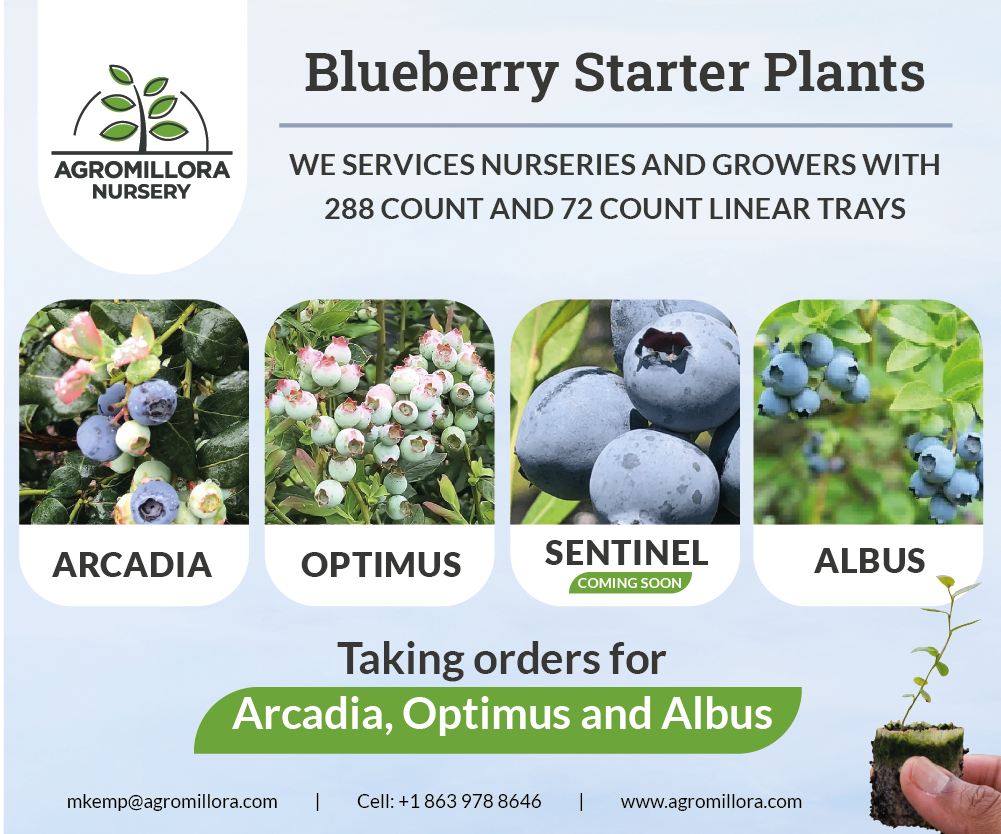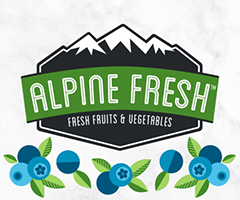Summer Irrigation and Fertilization of Southern Highbush Blueberry in Florida
Strong, healthy, vegetative growth is extremely important during the summer growing season. The wood that develops after summer pruning and before terminal bud set in the fall will contain most of the flower buds for next year’s crop. The goal is for plants to enter the late summer and fall (the major flower bud development period) with healthy shoots and leaves from growth that occurs during the summer. Pruning, pest and disease management, irrigation, and fertilization are all important practices that are necessary to achieve optimal summer growth. This article will outline some principles and suggested practices for irrigation and fertilization.
Irrigation and fertilization are closely linked because soil moisture is necessary for nutrient uptake by blueberry plants. However, excess soil water can damage root systems and cause leaching or runoff of essential elements and other chemicals, potentially contaminating ground water or nearby wetlands. Blueberry plant water use can be affected by many factors including, weather conditions, plant canopy size and shape, plant growth stage, plant health, crop load, and pruning practices just to name a few. Long, hot, summer days are generally consistent with high blueberry plant water demands. Previous research has shown that mid to late summer (July, August, and September) is the period of highest water demand for blueberry plants in Florida. During periods of peak water demand, water needs (from irrigation and/or precipitation) may exceed one inch per week. For example, prior research showed that mature “Emerald” plants growing in North-Central Florida used an average of about 2 gallons of water per day during July through September. Two gallons applied evenly to a bed area of 3 by 4 feet would be about 0.27 inches of water applied to that area. Blueberry plants are shallow-rooted, and most soils in Florida blueberry fields do not have high water holding capacities (Figure 1). Most Florida blueberry growers have beds comprised of a combination of native soil and pine bark, or in some cases just pine bark, neither of which have high water holding capacities. For purposes of this article, we will refer to each of these as “soil” or “blueberry soils.” At field capacity, the amount of water available for plant uptake is a function of the volume of soil occupied by the root system and the water holding capacity of the soil (or bark). Since blueberry root systems are typically shallow and blueberry soils are usually low in water holding capacity, frequent irrigations of short duration are usually needed during periods of high water demand. Growers often irrigate for short durations multiple times per day under high water use conditions, such as hot summer days. The objective is to apply irrigation to the depth of the blueberry root system but no deeper. Water from excess irrigation is not available for plant uptake and can leach nutrients and other chemicals below the root system. Knowledge of crop water use, rooting depth, water-holding characteristics of the soil, and wetting pattern of the irrigation system will help determine timing and duration of irrigation events. Soil moisture sensors can supply soil moisture data at various depths in the root system which can assist with proper irrigation scheduling. The goal is to keep the soil in the root zone in a targeted range by periodically replacing water lost through evapotranspiration. Two common groups of soil moisture sensors are: those that measure soil water (volumetric) content; and those that measure soil moisture tension. In most Florida blueberry soils, the sensors that measure soil moisture (volumetric) content perform better and are preferred to those that measure soil moisture tension. More information on soil moisture sensors is available at UF EDIS Publication BUL343, Field Devices for Monitoring Soil Moisture Content (Munoz-Carpena, 2021). Soil sensors should be placed in the root zone away from field edges and in representative areas of the field being measured. Multiple sensors positioned at different depths can provide information on when and how much to irrigate. If only one sensor is used, it should be placed at a depth in the middle of the root zone. Differences in plant size and age, cultivar, soil type, slope, and drainage can affect soil moisture and may require additional monitoring sites.
Fertilization Is Key
In addition to irrigation, fertilization is important to achieve healthy, vigorous summer growth needed for flower bud initiation and development for next year’s crop. The key element and fertilizer component that controls vegetative growth is nitrogen (N). While there are 13 other essential mineral elements, N is typically needed in greater amounts than most, and is critically important for vegetative growth. Blueberries differ from most plants by preferring the ammoniacal form of N as opposed to the nitrate form. Most fertilizers specifically formulated for blueberry will contain ammoniacal N or urea (which forms ammonium ions), and most blueberry fertilizers have an acidifying effect on the soil. Fertilizers that contain ammonium, or convert to ammonium, are available in dry granular, liquid (fertigation), and controlled or slow-release forms. Growers often use multiple forms of fertilizer to help ensure that nutrients are available under a variety of conditions. For example, dry granular fertilizer may be used in combination with slow or controlled release materials to potentially increase nutrient availability between applications. Blueberry fertilizer programs will likely also provide potassium (K) and other elements such as phosphorus (P), magnesium (Mg), sulfur (S) and micronutrients if a need is indicated by soil testing, leaf tissue analyses, or nutrient deficiency symptoms. Leaf tissue analyses are usually done at least annually to monitor the nutritional status of plants. It can be useful to evaluate, adjust, or modify fertilizer programs and identify long-term nutritional trends. Leaf samples are usually taken soon after harvest before summer pruning, or during mid-summer. Mature fully expanded leaves are used and different cultivars and different field conditions should be sampled separately. Table 1 shows highbush blueberry standard ranges of leaf tissue levels for the essential elements most likely to be included in a fertilizer program. Soil testing is critically important for new field establishment where changes to soil pH and nutrient content may be needed before planting. In existing plantings, soil testing is used to monitor soil pH, and levels of certain elements such as P, Ca and Mg (and salinity if necessary). It is critically important to maintain proper soil pH (4.5 to 5.5) to ensure nutrient availability and uptake. In many situations where irrigation water is high in carbonates, acidification of irrigation is needed to maintain the soil in the recommended pH range.
For mature bearing plants, the goal is to achieve a balance between vegetative and reproductive growth which will support both fruit yield and quality. The number of fertilizer applications is usually higher in Florida than in many other production regions because of the long growing season, sandy amended soils, and abundant summer rainfall. Many factors can impact the rate and frequency of fertilizer applications such as soil type or growing media, irrigation practices, plant age and size, planting density, cultivar, crop load, and season and plant growth stage just to name a few. Much like irrigation, fertilizer is usually best applied at frequent intervals in small amounts to minimize fertilizer loss through leaching or runoff and minimize periods between applications when nutrients may not be present in optimal amounts. Controlled and slow-release materials can also reduce fertilizer loss and increase use efficiency. Decisions on fertilization practices should be made based on soil and leaf nutrient analyses levels, stage of plant growth and development, season and environmental conditions, plant appearance, and grower experience.
Suggested Reading
Krewer, G. and J. Ruter. 2012. Fertilizing highbush blueberries in pine bark beds. University of Georgia Cooperative Extension Service. Bulletin 1291. https://secure.caes.uga.edu/extension/publications/files/pdf/B%201291_3.PDF
Munoz-Carpena, R. 2021. Field devices for monitoring soil water content. University of Florida Cooperative Extension Service. Publication BUL343. https://edis.ifas.ufl.edu/pdf%5CAE%5CAE26600.pdf
Phillips, D. A. and J.G. Williamson. 2020. Nutrition and Fertilizer Practices for Southern Highbush Blueberry in Florida. University of Florida Cooperative Extension Service. Pub. HS1356. https://edis.ifas.ufl.edu/pdf/HS/HS135600.pdf
Phillips, D. A. and J.G. Williamson. 2021. Irrigation Practices for Southern Highbush Blueberry. University of Florida, Cooperative Extension Service. Pub. HS1432. https://edis.ifas.ufl.edu/pdf/HS/HS1432/HS1432-Dx4nsu6ek6.pdf
Williamson, J.G., L. Mejia, B. Fergiuson, P. Miller and D.Z. Haman. 2015. Seasonal water Use of Southern Highbush Blueberry Plants in a Subtropical Climate. HortTechnology. 25: 185 – 191. https://journals.ashs.org/horttech/view/journals/horttech/25/2/article-p185.xml
Table 1. Essential mineral element levels for highbush blueberry.
|
Element |
Deficiency below |
Standard range for highbush |
Excess above |
|
|
Minimum |
Maximum |
|||
|
Macro elements |
|
|
|
|
|
Nitrogen (N) |
1.70% |
1.80 |
2.10 |
2.50 |
|
Phosphorus (P) |
0.10 |
0.12 |
0.40 |
0.80 |
|
Potassium (K) |
0.30 |
0.35 |
0.65 |
0.95 |
|
Calcium (Ca) |
0.13 |
0.40 |
0.80 |
1.00 |
|
Magnesium (Mg) |
0.08 |
0.12 |
0.25 |
0.45 |
|
Sulfur (S) |
0.10 |
0.12 |
0.20 |
NA |
|
Micro elements |
|
|
|
|
|
Iron (Fe) |
60 ppm |
60 |
200 |
400 |
|
Manganese (Mn) |
23 |
50 |
350 |
450 |
|
Zinc (Zn) |
8 |
8 |
30 |
80 |
|
Copper (Cu) |
5 |
5 |
20 |
100 |
|
Boron (B) |
20 |
30 |
70 |
200 |
|
Paul Eck, Blueberry Science, Rutgers University Press, New Brunswick, NJ NA=not available |
||||

Figure 1. Excavated southern highbush blueberry plant grown in a pine bark bed. The shallow, fibrous root system was primarily limited to the depth of the pine bark, with very few roots penetrating the underlying soil.
Credits: Jeff Williamson





